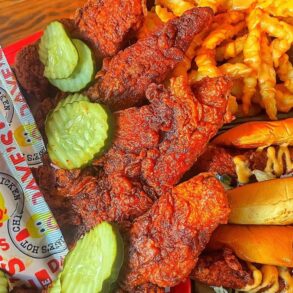
Who is Bozo Texino? That’s a good question in need of some explaining. But better to ask first: What is Bozo Texino?
Bozo Texino is graffiti. The marking is a simple image of a human head with a pipe or a hand-rolled cigarette—also known as a “quirly”—extending out of the side of the mouth, topped by a cowboy hat whose wide brim resembles the infinity symbol. Sometimes smoke-like dots rise above the cig. The name, often paired with the cowboy doodle, is an intriguing mix of “The World’s Most Famous Clown” from long ago and geographic-specificity with a hint of Spanish thrown in.
The drawing, which is sometimes in chalk or oil bar, started appearing on railroad cars and in railyards 90 years ago. For the next 50 years, Bozo Texino became an iconic figure among hobos, tramps, rail riders, and train buffs.
But Bozo Texino almost disappeared until Bill Daniel came along. Daniel is a filmmaker, photographer, and curator who grew up in Dallas. He once lived near the Santa Fe railyards next to Exposition Park where he developed a fascination with trains and, especially, boxcar graffiti. Here was an underground culture like the punk scene he knew.
That Daniel to ride the rails for 16 years, 16mm Bolex camera in hand, documenting the rail-riding culture in black and white “at considerable risk from speeding freight trains,” he says.
His adventures “in search of unknown folk heroes and graffiti artists,” as he describes them, culminated in an experimental documentary film, a DVD, and a book all about the 100-year tradition of hobo and rail worker graffiti, with a specific focus on the graffiti image of Bozo Texino.
Who Is Bozo Texino? The Secret History of Hobo Graffiti is a rugged ride on the rails with independent-minded, artistic misfits who choose to live outside traditional boundaries and laws.
The film is edgy and archival at once, drilling deep in the nomadic lifestyles of the hobo and the tramp, profiling graffiti artists including Herby, The Rambler, and buZ blurr aka The Colossus of Rhodes, while pointing out the differences separating hobos from tramps and bums. Austin punk rock trailblazer Tim Kerr contributed several tunes to the bluesy, acoustic soundtrack.
Since its completion in 2005, Who is Bozo Texino? has screened at over 400 venues, including the Museum of Modern Art in New York, Slab City at the Salton Sea, Key West, and earlier this year, Amsterdam, since its completion in 2005. He has earned numerous citations for his efforts. As he writes on his website, these accolades include “Illegal Inhabitation of a Motor Vehicle, a Guggenheim Fellowship, and a prized NYC Open Container Violation.”
I’m not going to give away the plot, other than to say there is resolution to Daniel’s question, and that Houston, San Antonio, and Laredo are involved. You’ll just have to watch the film to find out.
Daniel has occupied odd and unusual spaces around Texas over the years in Houston, Austin, San Antonio, Dallas, Pasadena, and New Braunfels, where he was caretaker of a shuttered textile mill. These spaces also include a warehouse in Galveston and a former washateria in Waxahachie. He is currently ensconced in a toyhauler RV in the Sacramento Delta of California, “eight feet below sea level,” while he’s fixing to move into a studio in San Francisco.
More Bozo Texino ephemera is tucked into the third edition of Mostly True, The West’s Most Popular Hobo Graffiti Magazine, a book disguised as a magazine, dated February 1923 but actually published last year by Microcosm Publishing in Portland. The fanzine of boxcar graffiti and railrider culture, and what Daniel describes as “obscure railroad nostalgia” further cements the bond between hobo and punk cultures.
Daniel credits punks for keeping the hobo and Bozo tradition alive. “Train punks rediscovered freight riding culture in the 1990s, co-inhabiting railroad jungles with the last of the previous generation of hobos, Vietnam veterans, primarily,” he says. “Punks have actively preserved and added to the culture. Who knows where the next generation will come from?”
Bozo Texino, the graffiti, is still around, even though the original artists who created him have been gone for decades. “There are other people who make the drawing and write the name in homage,” Daniel says.
As for the question, who is Bozo Texino? Daniel laughs. “The answer turned out much greater than the question. I’m still surprised at where ole Bozo still pops up,” he says. “Bozo Texino just keeps going in the world because of two things—graffiti culture and punk train rider culture. They’ve spawned a new form of rail fandom. The world of rail fandom now includes graffiti nerds and moniker nerds.”
This post was originally published on this site be sure to check out more of their content.








